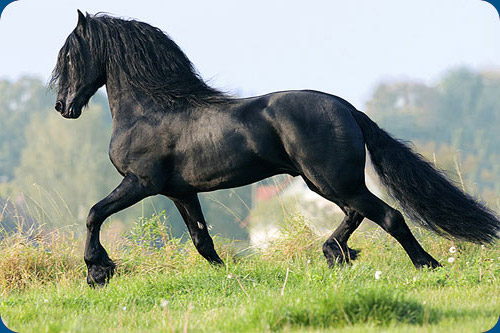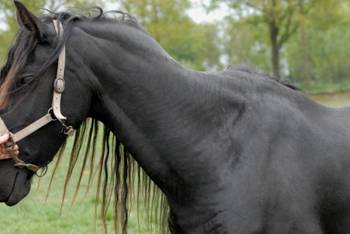Today I’d like to talk a little bit about one of my absolute favourite breeds of horses, and how dodgy breeders have managed to almost completely cancel them off my list of equines I’d like to one day own. Or at least, make my looking for a Friesian substantially more complicated.
Just look at that glorious beast. Friesians are stunning. Centuries of inbreeding have generated a horse that is nearly always black, with thick feathering and luxurious mane and tail, hawklike heads, and high-stepping front ends. However, as with all inbreeding stories, this causes problems. The front end of the Friesian is so heavily engineered, it almost looks as though the back end has been completely ignored in some individuals. However, this is the least of potential problems.
Kendall Park Friesian Stud openly acknowledges potential risks on their website, including dwarfism.
“Dwarfism is relatively rare in Friesians, but is still a real possibility of happening, and there are known cases. There are 2 types of Dwarfism – A chondrodystrophic, basically causes shorter legs, and Brachiocephalic, which results in more extreme disfigurements of bones, legs, face etc. Both types are debilitating to the horse.
It is thought that the Preferent Stallion Ritske 202 has most likely had a large impact on Dwarfism, but also Wessel 237 and Oege 267 are thought to have been carriers of the gene as well. At present it is estimated that there are 12 Studbook Stallions that are carriers of the Dwarfism gene.”(http://www.kendhallparkfriesians.com.au/Friesian%20Health%20History.html)
The fact that these stallions are still in the studbook at all is a huge worry. The fact that this stud is openly acknowledging the risk shows a good level of responsibility on their part, but the same transparency and name-dropping is not widespread. Kendall Park lists several other potential genetic issues with Friesians on their website, including water on the brain, which is well worth a look if you are interested in potentially purchasing a Friesian horse in the future.
In addition, there is also the risk that the Friesian’s iconic, massive crest can be subject to weakness, the causes of which have not yet been fully researched.
 That looks practical, doesn’t it? Frustratingly, the Friesian Studbook’s response has been to “grade” levels of crest degradation in its elite breeding horses, rather than remove affected horses from the gene pool. These crests will be noted, but are not grounds for elimination from Premium, Star, Crown, and Model ranks. Let the sagging continue! Here’s what it looks like in its more pronounced form.
That looks practical, doesn’t it? Frustratingly, the Friesian Studbook’s response has been to “grade” levels of crest degradation in its elite breeding horses, rather than remove affected horses from the gene pool. These crests will be noted, but are not grounds for elimination from Premium, Star, Crown, and Model ranks. Let the sagging continue! Here’s what it looks like in its more pronounced form.
Kendall Park Friesians cites Waling Haytema, a veterinarian and associate of the ‘Dierenkliniek Wolvega’ (Animal clinic) and member of the KFPS Breeding Council, in their acknowledgement of this issue: “With the advance of age some horses develop an unstable, sometimes fallen or broken crest. Up to now this problem has not been researched, therefore we cannot define the obvious causes. It is generally believed that there are two possible factors that seem to be involved in the development of a fallen crest.
The first cause for a fallen crest may be the occurrence of inflammation of fat tissues, steatitis, in young horses. The crest has a fair amount of fat deposits. Inflammation in these fat deposits produces connective tissues. The tendency for a weak crest thereby is formed at a young age but will start to show at a later age when the connective tissues lose their elasticity. Fat disease is considered to be an expression of deficiencies in antioxidants, especially vitamin E and selenium deficiency. In this light it is crucial that young horses have a sufficient intake of vitamins and minerals.
Another contributing factor could be obesity in horses when too much fat tissue is stored in the crest. If the horse is subsequently put on a diet and the fat tissue is reduced, what remains is weak connective tissue.”
Equinews also lists several other conditions, including skin, heart, esophagus and immune system issues, that are overrepresented in Friesian horses. Even more excitingly, we don’t yet know why these issues keep occurring. For example,
“Many Friesians suffer from chronic dermatitis that causes thickened and ulcerated skin on the pasterns. The lesions are often unresponsive to treatment. Though other draft breeds also have this problem, Friesians are overrepresented, and a genetic cause is suspected but has not been proven.” (http://www.equinews.com/article/health-problems-friesian-horses)
Yay! Insufficiently researched painful conditions that don’t respond to treatment! Just what everyone wants for their horse.
All in all, this is a pretty poor turnout for such a treasured breed. Breeding Friesians has been a highly focused process for years. It seems ridiculous that so little research has gone in to understanding what causes these problems and limiting their spread. Plenty of equine breeds have their share of genetic quirks and predispositions, for better or worse, but Friesians seem to have collected a pretty nasty set, all in the name of long hair and a black coat. All that I can say is that if I end up looking at a Friesian horse in the future, I will be doing a much more thorough genetic history research than I had initially planned. Or looking at an out-cross.



